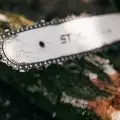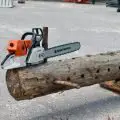A chainsaw is a piece of essential equipment for cutting wood, felling trees, bucking, and other tasks. Before purchasing a chainsaw, consider the purpose of the purchase as well as the qualities of the chainsaw you select.
The ripping chain and crosscut chainsaw chains are two types of chainsaw chains that every woodworker should be familiar with along with their benefits and drawbacks.
In this article, we’ll take a dive into ripping chain vs crosscut chain, comparing their advantages and disadvantages, so that you can decide which one is better for you!
Table of Contents
- What Is a Ripping Chain?
- What Is a Crosscut Chain?
- Ripping Chain vs Crosscut Chain: Which Is Better?
- FAQs (Frequently Asked Questions)

What Is a Ripping Chain?
A ripping chain is a semi-chisel alternative that is used on shallow-angle cutters with a cutting angle of roughly 10°. It slices along the wood grain rather than across the pores or veins, which distinguishes it from other market options.
This specialty chain is used for milling, hence it can only be utilized for certain projects requiring smoother wood surfaces. They have various characteristics and advantages over a standard cross-cut chainsaw blade, which is ideal for cutting timber planks.
Advantages of a Ripping Chain
Smooth Cut Finish
When using a ripping chain, you move following the grain, which means the saw is not breaking through and splitting wood fiber, resulting in a splintered rough finish.
Instead, a shaving of wood following the grain is used, resulting in a better surface finish. To help cut through a smooth milled finish, ripping chains frequently have two clearing cutters followed by two scoring cutters in sequence along the chain.
Semi-Chisel
Ripping chains are invariably micro-chiseled or semi-chiseled with a cutting angle of 5-10 degrees, but most commonly 10 degrees. Because of the low cutting angle, using a ripping chain to cut at a steep angle will not yield the optimum results.
The semi-chisel profile maintains the chain sharper for a longer period of time, resulting in a cleaner finish and improved user performance.
Durable Design
This chain’s design allows for a smoother cut and less vibration and chainsaw kickback, implying that it will last even if you strike debris. As previously stated, the 10-degree cutting angle also retains its sharpness for a longer period of time.
Disadvantages of a Ripping Chain
Slow Cutters
Ripping chains are more time-consuming since the finer cut and surface require more time than standard cutting chains. If speed is important to you, this chain may not be the best choice.
What Is a Crosscut Chain?
A crosscut chain, otherwise known as a standard chain, is a chainsaw chain that cuts wood across the grain. A full-chisel or semi-chisel chainsaw chain can be used. A standard chain is available in a full-chisel chain and semi-chisel chain varieties, each with advantages and disadvantages.
Because these chains are designed for steeper cutting angles ranging from 25° to 35°, they may not be the best solution if you need to cut at a harsher angle.
Advantages of a Crosscut Chain
Wider Cutting Angle
With cutting angles ranging from 25 to 35 degrees, you may cut at both steep and shallow angles without sacrificing performance.
Cutting Speed
A standard chain will provide you with faster cutting speed, making it an excellent choice for most cutting operations.
More Versatility
Crosscut chainsaw chains are referred to as “standard” for a reason…the jack of all trades. They can be used for a variety of tasks when the surface finish is not a major consideration. Cutting firewood, falling trees, and other such tasks. Because of the sharper angle of the cutters, it’s a good all-arounder.
Disadvantages of a Crosscut Chain
Prone to Wear
Standard chains wear out faster and must be replaced more frequently.
Rough Finish
They also produce a rougher finish, which means you must spend more time sanding and smoothing if the finish quality is important.
Ripping Chain vs Crosscut Chain: Which Is Better?
| Chainsaw Ripping chain | Chainsaw Crosscut Chain | |
|---|---|---|
| Design | Ripping chains are micro-chiseled, round-cornered chains. | Crosscut chains have square corners and can be micro-chiseled or full-chiseled. |
| Durability | Ripping chains are extremely durable since they have a low recoil and are not easily damaged. | Crosscut chains are brittle. They provide more kickback than ripping chains and are more easily damaged. |
| Finishing | A smooth finish is provided by ripping chains. | Crosscut chains have a more unyielding appearance. This means you’ll still have to sand the finished product. |
| Safety System | Kickback protection is standard on most chainsaw-ripping chains. | Crosscut chains contain extra bumper links that help decrease chainsaw kickback. |
| Sharpened Teeth Angle | Most ripping chains have sharpened teeth that are at 10 degrees. | Most crosscut chains have sharpened teeth that are at 35 degrees. |
Cutting Angles
Chainsaws with a large cutting angle make your task easier and more effective by allowing you to cut shallow angles without sacrificing productivity. When it comes to cutting tips, the crosscut chain has the upper hand.
Crosscut chains feature a greater movement range and a larger cutting angle of 25 to 35 degrees. Chainsaw ripping chains, on the other hand, have a cutting angle of 5 to 10 degrees, resulting in a smaller cutting angle than crosscut chains.
Cutting Speed
Who wouldn’t desire a chainsaw with a quick cutting speed? The faster your chainsaw chain cuts, the faster you can complete your project.
Crosscut chains cut at a considerably faster rate than ripping chains. This makes it an excellent option for the majority of woodworking operations. Although chainsaw ripping chains cut through wood quickly, they are substantially slower than most chainsaw chains.
Their circular edges, on the other hand, make them very easy to sharpen and may keep their sharpness for a long time when cutting. This is an advantage they have over the crosscut chain.
Durability
The durability of a chainsaw ripping chain and a standard cross cut chain differs greatly. One of the most important considerations when selecting a chainsaw is its durability, how long it will endure, and how efficiently it performs.
Chainsaw ripping chains are designed to provide minimal kickback and vibration. This means it is not readily spoiled or damaged. The 10-degree angle maintains the blade sharp for extended periods of time, reducing the need for frequent sharpening.
On the contrary, the steeper cutting angle provided by crosscut chains produces more kickback. This makes it more prone to harm. Crosscut chains must also be sharpened more frequently.
Maintenance is imperative, visit our Chainsaw Maintenance Checklist and Chainsaw Bar Upkeep and Maintenance to learn all the necessary steps you should be taking!
Versatility
Ripping chains are limited in their versatility and are better suited to cuts that demand a smooth finish.
Crosscut chainsaw chains are extremely versatile and functional. They can be used for any wood-cutting and finishing task. The sharp angle of the crosscut chainsaw makes it handy for a variety of tasks. Bucking, limbing, trimming, chopping firewood, and many other applications are possible using crosscut chains.
A standard chainsaw chain, however, has a coarser finish than ripping chains. They also require more sharpening than ripping chains. Learn all about chainsaw sharpening chains in our How to Sharpen a Chainsaw Chain and How Long Do Chainsaw Chains Last guides!
Finally, it all comes down to the kind of woodworking profession you’re in. Are you an experienced chainsaw user or a beginner? Is this a heavy-duty job or something lighter?
In any event, keep in mind that chainsaw ripping chains come in helpful when cutting shallow angles and need a smooth cut. Crosscut chains are ideal for steeper cuts and provide a larger cutting angle.
Learn more about chainsaw chains in our Types of Chainsaw Chains guide!
FAQs (Frequently Asked Questions)
Does a ripping chain make a difference?
Yes. Because the ripping chain does not cut along the pores and instead mills with the grain, the finish is smoother and cleaner than alternatives on the market.
What is the difference between a ripping chainsaw chain and a regular chain?
Ripping chain cutters cut at a lower angle than regular chainsaw chain cutters – 10 degrees against 30 degrees. The ripping chain also cuts with the grain of the wood rather than against it. As a result, the ripping chain, contrary to its name, removes smaller bits of wood and is less aggressive.
Do you need a ripping chain for a chainsaw mill?
If you’re milling and want a nice finish on your cuts, a Ripping chain is far superior to a conventional x-cutting chain. When chainsaw milling, a properly sharpened and maintained ripping chain is important to getting the finest possible end product.
What is the advantage of a skip tooth chain?
A skip chain has fewer cutting teeth than a standard chain, so it won’t drag as many teeth through the wood you’re cutting. With less drag on the chain, less power is required to cut through the log. That means your saw’s motor will operate faster, keeping it in a more efficient power curve.





